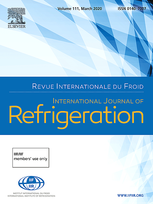
Document IIF
Un modèle de transfert de chaleur à changement de phase par évaporation validé expérimentalement pour les applications à faible flux massique utilisant le R134a dans les échangeurs de chaleur à plaques.
An experimentally validated evaporative phase change heat transfer model for low mass flux applications using R134a in plate heat exchangers.
Auteurs : SIMON III J. R., BANDHAUER T. M.
Type d'article : Article de la RIF
Résumé
Plate frame heat exchangers are common in liquid-coupled vapor compression systems due to their compactness and ease of maintenance. In some of these systems, the refrigerant within the evaporator can enter the heat exchanger as a subcooled liquid. As a result, the refrigerant passes through three different phases: single-phase liquid, two-phase fluid, and a superheated vapor. Unfortunately, there have been limited prior studies that have identified the best method to predict performance under these circumstances. Furthermore, previous investigations have not evaluated refrigerant evaporation in large industrial sized plate frame heat exchangers under conditions experienced in the present study experimental test facility, especially at mass fluxes below 7 kg m−2 s−1. In the present investigation, a model was developed to predict the performance of plate and frame heat exchangers when the fluid enters as a subcooled liquid and exits as a superheated vapor. The model used full-sized plate heat exchanger geometry that was discretized into 20 sections to accurately capture local heat transfer and pressure drop effects. The model was validated using an R134a counter flow heat exchanger used in a turbo-compression cooling system test facility that had subcooled liquid entering the evaporator at low mass fluxes. A variety of empirical correlations were evaluated to determine what combination yielded the best predictive capability over the following range of conditions: 5.8 < G < 6.8 kg m−2 s−1, 2 < q″ < 2.8 kW m−2, and 10 °C < Tsat < 15 °C. When the correlations used a fixed control volume length in the heat flux calculation, the most accurate combination resulted in a mean absolute error of 5.5%. Future studies can use the approach described here to optimize heat exchanger size and performance.
Documents disponibles
Format PDF
Pages : 604-614
Disponible
Prix public
20 €
Prix membre*
Gratuit
* meilleur tarif applicable selon le type d'adhésion (voir le détail des avantages des adhésions individuelles et collectives)
Détails
- Titre original : An experimentally validated evaporative phase change heat transfer model for low mass flux applications using R134a in plate heat exchangers.
- Identifiant de la fiche : 30029167
- Langues : Anglais
- Sujet : Technologie
- Source : International Journal of Refrigeration - Revue Internationale du Froid - vol. 131
- Date d'édition : 11/2021
- DOI : http://dx.doi.org/10.1016/j.ijrefrig.2021.08.003
- Document disponible en consultation à la bibliothèque du siège de l'IIF uniquement.
Liens
Voir d'autres articles du même numéro (95)
Voir la source
-
Effect of flow direction of heating medium on b...
- Auteurs : SHIKICHI K., MINOURA K., ASANO H.
- Date : 09/07/2018
- Langues : Anglais
- Source : 2018 Purdue Conferences. 17th International Refrigeration and Air-Conditioning Conference at Purdue.
- Formats : PDF
Voir la fiche
-
Compensating for the end-plate effect on heat t...
- Auteurs : LI W., HRNJAK P.
- Date : 06/2021
- Langues : Anglais
- Source : International Journal of Refrigeration - Revue Internationale du Froid - vol. 126
- Formats : PDF
Voir la fiche
-
Experimental investigation of condensation and ...
- Auteurs : TUN T., YOSHIDA K., DIAW S., KARIYA K., MIYARA A.
- Date : 06/2021
- Langues : Anglais
- Source : 2nd IIR Conference on HFO Refrigerants and Low GWP Blends
- Formats : PDF
Voir la fiche
-
Oil circulation effects on evaporation heat tra...
- Auteurs : JANG J., CHANG Y., KANG B. H.
- Date : 16/07/2012
- Langues : Anglais
- Source : 2012 Purdue Conferences. 14th International Refrigeration and Air-Conditioning Conference at Purdue.
- Formats : PDF
Voir la fiche
-
Experimental study on flow boiling of R410A and...
- Auteurs : PADOVAN A., CENSI G.
- Date : 01/09/2021
- Langues : Anglais
- Source : 6th IIR Conference on Thermophysical Properties and Transfer Processes of Refrigerants
- Formats : PDF
Voir la fiche
